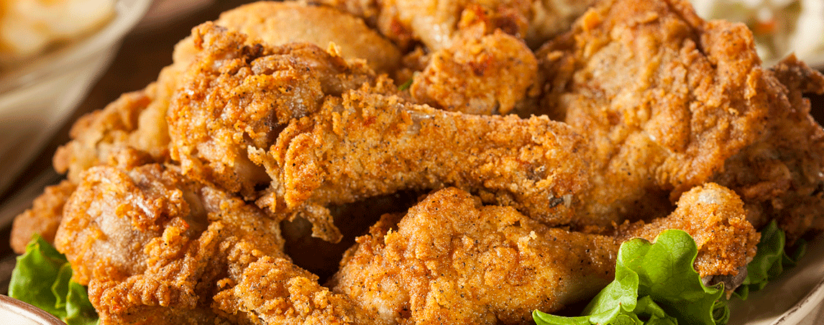
What’s the difference between white and dark chicken?
02/07/2017
White or dark meat? It’s a familiar question when it comes to choosing a piece of chicken. But besides color, what is the difference between white and dark meat?
We turned to two trusted experts at the University of Arkansas Dr. Janeal Yancey, meat scientist, and Dr. Casey Owens-Hanning, poultry scientist, to learn about the different cuts of chicken and explore the best uses for each type.
White meat cuts are the breast, breast tenders and wings. Dark meat cuts are the drumstick and thighs. The color differences occur because they are two separate types of muscle.
 Dr. Yancey: “Different muscles in the animal are used to do different things. Dark cuts, like the drumsticks and thighs, are used for holding the animal up and walking, so they are required to work for long, sustained periods of time. Whereas, white cuts like the breast and wings are required to perform short bursts of energy, like flapping their wings.”
Dr. Yancey: “Different muscles in the animal are used to do different things. Dark cuts, like the drumsticks and thighs, are used for holding the animal up and walking, so they are required to work for long, sustained periods of time. Whereas, white cuts like the breast and wings are required to perform short bursts of energy, like flapping their wings.”
The dark and white cuts of meat apply to both chicken and turkey. Because these muscles have different uses, they have different types of metabolism. In contrast, breast meat of duck is actually dark meat because ducks fly and use that muscle for long, sustained periods of time, Dr. Owens-Hanning said.
Dr. Yancey: “Dark meat cuts come from muscles that use more oxygen and have more iron. The iron is held in a protein called myoglobin, which gives it the darker color. White meat cuts come from muscles that metabolize energy with less oxygen, so they have less myoglobin and are lighter in color.”
All chicken is a good source or protein, as well as niacin, vitamin B6, biotin and vitamin B12. The experts say there is a slight difference in chicken nutrition between white and dark meat. Dark meat, because of the type of muscle, has slightly more iron. The biggest difference is the amount of calories and fat in the pieces.
Dr. Yancey: “Typically a boneless, skinless breast and breast tenders will have the least fat and fewest calories of any cuts of chicken.”
Dr. Owens-Hanning: “Dark meat will have more fat, but much of this comes from fat in between muscles. Since the leg meat (drumstick and thigh) are made up of multiple muscles, there is generally more fat than white meat. Furthermore, fat around the breast meat cut (one single muscle) is more easily trimmed than fat in between muscles found in the leg.”
Fat in chicken is most often found in the skin, she explained. So, boneless skinless breast (white meat) and skinless thighs (dark meat) are both relatively lean cuts of meat that are commonly found in supermarkets. Pieces with the skin, typically drumsticks and wings, have higher fat content.
How do the cuts of meat compare in taste and flavor?
Dr. Yancey: “Dark cuts like the drumstick and thigh have a little bit stronger flavor, mostly due to increased fat content because many flavor compounds are fat soluble. Additionally, the dark meat will tend to be juicier, again due to the increased fat content. White meat cuts are milder in flavor and may need flavors added to them, whereas dark meat cuts are able to stand on their own in the flavor department.”
When cooking chicken, keep in mind the type of meat to determine the best way to prepare it.
Dr. Owens-Hanning: “White meat can tend to dry out quickly so it is helpful to cook in a moist environment, such as baking or in a covered skillet, and to avoid overcooking. Using a meat thermometer to cook to 165 F, and not substantially more, is helpful with this.”
It seems that white meat is more popular. We asked the experts what might be the reasons for that.
Dr. Yancey: “I have heard a chef say, ‘a chicken breast is a chef’s blank canvas.’ It is the leanest and, even when boneless, it is a large cut that makes a nice serving size. Because of the mild flavor of the breast, it can easily be added to all types of dishes and take on a variety of flavors so it is very versatile.”
Dr. Owens-Hanning: “Breast meat tenders (white tenderloin muscle that lies underneath the breast muscle) are very popular due to the serving size and its use in fried foods. Fried foods are still very popular in fast food and food service.”
Dr. Yancey: “The other white meat cut is wings and they have been made popular by their size and the ‘buffalo wing’ craze in appetizers and snacks.”
To give you some ideas for dark meat dishes, we created a Pinterest board. It includes Dr. Yancey’s family recipe for pozole. Dr. Owens-Hanning shared her favorite ideas: “I like to marinate boneless skinless thighs in a teriyaki marinade and cook in a skillet. Another favorite of mine is cooking turkey breast cutlets in the skillet with whatever seasoning I have on hand.”
No matter what you’re cooking, keep food safety in mind. “Chicken needs to be cooked to 165 F regardless of it being dark meat or white meat,” Dr. Yancey said. “Always check the temperature with the thermometer inserted into the thickest part of the cut. For bone-in cuts, that may be next to the bone.”
White and dark chicken meat is due to different types of muscle. The cuts have different flavors and fat content and can be used in a variety of ways in cooking.



























